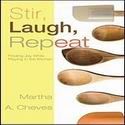Wednesday, October 27, 2010
Diabetic Salad Dressing
1/2 cup water
1/2 cup white vinegar
1/2 tsp. salt
1/2 tsp. dry mustard
1/8 tsp. pepper
1/16 tsp. paprika
Artificial sweetener to substitute for 4 teaspoons sugar
Combine and refrigerate.
Yield: 1 cup.
Chef Tom Cooks
Review Stir, Laugh, Repeat at Amazon.com


Tuesday, October 26, 2010
Spice Up Your Cooking With Herbs
A great article that will help you create great recipes by using herbs. I wanted to share.
Whether you grow them yourself or buy them at the grocery store, herbs are a healthy and delicious way to season foods without extra calories.
No one wants to eat bland food, but ladling on sauces and gravies just adds excess fat and calories to your diet. Fortunately, calorie-free herbs add flavor without all that extra baggage, and they’re easy to use.
Herbs are edible, fragrant plants that add flavor and nutrients to many types of foods. By playing with herbal variations in your recipes, you can get a completely different taste every time you cook. Stock up on dried or fresh herbs at the grocery store or farmers’ market, or grow your own herbs indoors or out.
Fresh Herbs, Dried Herbs: What’s the Difference?
The biggest differences between dried herbs and fresh herbs are the taste and the potency of the herb, says registered dietitian Sandra Meyerowitz, RD, LD, MPH, founder of Nutrition Works in Louisville, Ky. Fresh herbs have a subtler, fresher taste, and you’ll need a much greater quantity of fresh herbs than dried herbs for the same taste effect. Be sure to follow recipe directions closely.
As for nutritional benefits, dried herbs and fresh herbs are similar, but not exactly the same, says Meyerowitz. “Leaving dried herbs around for a long time can diminish their potency.” Phytonutrients, the natural components in herbs that provide health benefits, diminish with age.
When choosing dried herbs, she advises, it’s best to buy organic so you’re sure the herbs have not been irradiated. When you're buying fresh herbs, whether at the grocery store or a farmers’ market, be sure to get them as close as possible to the day you plan to use them.
Preparing Fresh Herbs
Before cooking with fresh herbs, you'll need to wash them carefully. Rinse the herbs underneath running water, then place them on a paper towel or shake them off to dry. If you're cleaning large leaves like basil or a large bunch of parsley, place them in a bowl of cool water and swirl it around. Transfer the herbs to a clean bowl of water and continue to rinse until the water stays clear. Then dry them off and prepare them for cooking. Generally, you just want to use the leaves, not the stems, of the herb.
Storing Fresh Herbs
Fresh herbs need air to keep them fresh. Store them in the refrigerator in a plastic bag; just make sure that the bag is either open or that it has air holes poked in it. Keep them in the crisper for the most freshness.
Another way to keep herbs fresh is to place them in a glass or vase like flowers, making sure to cut off the ends immediately before placing them in about an inch of water. Put them in fresh water each day, and keep them stored in the refrigerator. Use them as soon as you can, as the flavor can become weaker with time.
Growing Your Own Herbs
Growing herbs is not difficult. Here are some herbs that won’t challenge your green thumb and will add delicious flavor to your meals:
- Oregano and basil for pasta dishes and sauces
- Rosemary and thyme for chicken and vegetable dishes
- Dill for cauliflower, cucumbers, and fish and fish sauces
- Parsley for fish, soups, vegetables, and tomato sauce
- Mint for salad, beverages, and desserts
- Marjoram for stews, soups, and eggs
- Cilantro for Mexican and Thai dishes
- Tarragon for yogurt and sour cream, beans, and roasted chicken
Besides being easy to grow, fresh herbs are convenient to just pluck as you need them, clean them, and add them to your dish. Try to pick herbs in the morning when the flavor will be best and the herbs will be at their freshest.
Growing your own herbs allows you to control how they’re grown — you can rest assured that they're pesticide-free and grown in organic soil when you have your own indoor or outdoor herb garden. You'll need to follow individual growing instructions for each herb because each one grows best in certain soil and temperature conditions; some may need sun while others prefer shade, and some may require more space to grow than others.
Whether you opt for fresh or dried, herbs are great ingredients in healthy recipes, allowing you to enjoy meals that are full of flavor, while sparing you the extra calories.
Review Stir, Laugh, Repeat at Amazon.com


Monday, October 25, 2010
Diabetic Chicken Cacciatore
Ingredients
1 cup sliced mushrooms
1 cup tomato sauce
1 16-ounce can whole plum tomatoes
1/2 cup white wine (or cooking wine)
1/4 tsp. basil
1/4 tsp. oregano
1 bay leaf
2 tsp. minced garlic
1 chopped onion
4 half chicken breasts, skinned, boned
2 Tbsp. fat-free chicken broth
Directions
Heat liquid chicken broth in a non-stick skillet and brown chicken, onion, and garlic. Add all other ingredients except mushrooms. Bring to a boil, then cover and simmer about 30 minutes.
Add mushrooms, cook 10 minutes more. Remove chicken from pan, boil down sauce until slightly thickened. Serve over cooked rice.
Chef Tom Cooks:
Review Stir, Laugh, Repeat at Amazon.com


Wednesday, October 20, 2010
Carrot Cabbage Slaw
1/2 head cabbage
1 sm. onion
2 celery stalks
2 carrots
1 tbsp. mayonnaise
2 pkg. Artificial sweetner (such as sweet n low)
1/2 tsp. black pepper
2 tbsp. vinegar
2 tbsp. lemon juice
Shred cabbage and carrots. Finely chop onion and celery. Mix together in a large bowl. In a separate bowl, mix together sweetner, pepper, vinegar, lemon juice, and mayonnaise. Pour over shredded vegetables and refrigerate.
Makes 10 servings.
Chef Tom Cooks
Sunday, October 17, 2010
How Fermented Foods Aid Digestion
Kefir, kimchi, sauerkraut, sourdough bread, and yogurt are all surprisingly good for your digestive system. Get some ideas for adding a fermented food or two to your diet.
By Madeline Vann, MPH
If you think about fermentation at all, you probably think about alcohol. But there are many other kinds of fermented foods — such as yogurt — out there. Fermented food uses microorganisms to convert sugars into lactic acid, creating a signature sour taste.
That sour taste — which many people may find unfamiliar — should not be equated with unhealthy or expired. In fact, including fermented foods in your diet a few times a week or more could be beneficial for your health.
Fermented foods include:
- Miso. A paste made of fermented soy beans, it forms the base of soups or glazes.
- Sauerkraut. This familiar condiment is made of finely shredded fermented cabbage.
- Sourdough bread. Real sourdough bread is made with milk and other foods that have been allowed to ferment before making the bread dough.
- Kefir. A fermented drink made from milk.
- Yogurt. Yogurt includes live bacteria called probiotics.
- Kimchi. A traditional Korean dish made from pickled vegetables like cabbage or radish.
- Buttermilk. Buttermilk also includes probiotics.
- Natto. These fermented soybeans are a traditional Japanese breakfast dish.
- Poi. A fermented paste made from taro root.
- Tempeh. A cake made of fermented soybeans.
The Benefits of Fermented Foods
“Fermentation is almost like the beginning of digestion,” explains dietitian Sheah L. Rarback, MS, RD, director of nutrition at the Mailman Center for Child Development at the University of Miami Miller School of Medicine in Florida. Because of this process, for example, many people who can’t tolerate milk can comfortably eat yogurt.
Fermented foods are not always labeled as such. For example, you may see the term cultured instead of fermented, but these terms refer to foods that have similar health benefits. Foods that are labeled “pickled” are also fermented foods. Also, fermented foods may contain probiotics.
These good bacteria provide the digestive health benefits associated with fermentation.
Rarback says fermented foods “are a way to put your colon back into balance. Also, the fermented foods even help your body digest, absorb, and get better use of the foods you’re eating.” You may need to eat these foods more if you are taking antibiotics or if you have other health conditions that make it hard to digest foods. Some people are less able to digest certain enzymes as they get older. “Fermented foods counter that process,” Rarback says.
Getting Fermented Foods in Your Diet
Even if you know that including kefir or miso in your diet is good for you, adding them into your weekly meal plan can be a bit more challenging. The taste of fermented foods — even a well-known supermarket item like sauerkraut — may seem a bit exotic or unfamiliar.
Rarback advises taking baby steps and gradually increasing your consumption. “Any time you’re adding new foods into the diet, don’t overload,” she says. The last thing you want to do is get turned off or overwhelmed by the new palate.
For example, Rarback says she enjoys plain Greek yogurt now that she has been including it in her diet for a while.
Manufacturers are responding to the public’s wariness with new products. Kefir is a good example. It is increasingly available with added flavors, such as strawberry.
You can also turn to the Internet for recipes and ideas. “A lot of these foods are not a part of our typical diet, so go online and look up miso cooking, for example,” suggests Rarback, who says she took a macrobiotic cooking class that taught her how surprisingly simple it is to prepare miso soup or a miso glaze for fish.
“Just because it’s exotic and new doesn’t mean it’s difficult,” she says.
She also warns against prepackaged foods. For example, you may not get the same fermentation benefits from prepackaged sourdough bread or just-add-water miso soup as you would if you made it yourself or bought it from a local authentic vendor.
Some fermented foods come with a lot of salt. “You still need to read food labels,” says Rarback, who says that people who are watching their salt may need to pay careful attention to the details of the fermented foods they want to try.
Review Stir, Laugh, Repeat at Amazon.com


Blueberry Crisp - Another Chef Tom Recipe
2 cups Blueberries -- fresh or frozen
1 tablespoon Flour
1 tablespoon Splenda
--Topping--
1/2 cup Oatmeal (slow cooking- not quick)
1 teaspoon Cinnamon
1 tablespoon Flour
1 tablespoon Splenda
2 tablespoons Butter or Margarine -- melted
Blend together flour and Splenda in a large bowl. Mix with blueberries and
place in a 9x9 inch baking dish or pan.
Topping-
Mix all topping ingredients together in a large bowl. Sprinkle on top of
blueberry filling in pan. Bake at 350 degrees F for 45 minutes.
Chef Tom Cooks
Review Stir, Laugh, Repeat at Amazon.com


Thursday, October 14, 2010
Choosing Kids' Breakfast Cereals
You want a breakfast cereal that is high in fiber and low in sugar. Your kids just want the one in the coolest-looking box. Here are 10 tips for choosing a healthy breakfast cereal.
A supermarket’s cereal aisle is loaded with breakfast cereal choices — enough to make your head spin. How do you, as a parent, choose wisely so your kids are eating a healthy breakfast? The key is to read the nutritional information and not the marketing slogans shouting from the brightly colored boxes.

Here are 10 tips for choosing a healthy breakfast cereal that will deliver great kids’ nutrition:
1. Go for high fiber. A healthy breakfast cereal should have at least 3 grams of fiber per serving, says Suzanne Farrell, MS, RD, a Denver-based spokeswoman for the American Dietetic Association. “Breakfast is an excellent time to sneak more fiber into your kids’ diet.” It doesn’t matter whether it’s soluble or dietary fiber as long as it has at least 3 grams, she says. The higher the fiber content of the breakfast cereal, the longer they’ll feel full after eating it.
2. Count the calories. “A good guideline is a cereal that has about 150 calories or fewer per serving,” Farrell says. Check the serving size. “The serving size of some of your more dense cereals may be smaller than you’re used to.” A good serving size is 3/4 to 1 cup. Your kids should feel full if they eat that amount.
3. Look for low sugar. “I love for the sugar content to be in the single digits,” Farrell says. “So anything that’s less than 10 grams is okay. A rule of thumb is to stick to those that are 6 to 8 grams.” No one type of sugar is better than another, Farrell says. Some studies suggest that consuming high-fructose corn syrup can trigger the body to crave more sweets. High-fructose corn syrup is one of the more popular sugars added to foods, including breakfast cereals, Farrell says, “but sugar is sugar, whether it’s high-fructose corn syrup or molasses or honey, and the body will metabolize it as sugar.”
4. Don’t be fooled by granola. People assume that granola is a healthy breakfast food. “But some granolas can be high in sugar, fat, and calories,” Farrell says. If your kids like granola, buy them some, but use it sparingly. “Think of it as a condiment for the top of a lower-calorie, lower-sugar cereal,” Farrell suggests. Also beware of cereals labeled “low-fat” or “fat-free” as they may actually be higher in sugar and calories. Read the label and see for yourself.
5. Get the “whole” picture. As with all foods, breakfast cereal ingredients will be listed in the order of their highest to lowest concentration. When looking for the best in kids’ nutrition, you want the very first ingredient listed on the cereal box to be a whole grain. It could be whole wheat, whole oats, or whole oat flour. “When you see the world ‘whole,’ it’s indicative of whole grain,” Farrell says. Just "wheat" alone, however, does not necessarily mean whole wheat.
6. Run hot and cold. Both hot and cold cereals can meet the criteria for healthy breakfast choices, Farrell says. “I buy both and give my daughter the option of whether she’d like hot or cold each day. Variety is key,” she adds. “You want to change it up.” Of course, hot cereal can be especially comforting on a cold morning. Make it with milk to add some protein to the meal.
7. Consider going generic. Choosing brand names over store or private labels doesn’t really matter, Farrell says. Store-brand or generic cereals can be just as nutritious as the brand names. “In these economic times, it’s definitely worth it to check out the generic. Definitely give those a chance,” she advises.
8. Organic isn’t a must. When it comes to cereal, organic is not superior, Farrell says — it’s more a matter of personal preference. If you want your kids to eat only organic, buy organic cereal, but it’s not necessary for kids’ nutrition, she says. When it comes to putting fruit on top of the cereal, that’s where you may want to choose organically grown, she explains. And keep in mind that a cereal labeled “natural” doesn’t mean it’s any better either, Farrell says. It still could be high in sugar and sodium.
9. Go for the vitamins and minerals. Most breakfast cereals are fortified with vitamins and minerals, enough to supply approximately 25 percent of the daily value. Some have much more. If your kids are taking vitamins, 25 percent is good. If not, maybe you want those with a higher percentage.
10. Pick what your kids like. You might buy the best cereal in terms of kids’ nutrition, but if they don’t like the taste, they won’t eat it, and you’ve wasted your money. If they only want high-sugar cereals or ones with chocolate bits, give them some, but in small amounts. Mix their favorites with yours, Farrell says. That way you both will be happy.
Don’t let the choices in the cereal aisle overwhelm you. Read labels, not marketing slogans, and look for breakfast cereals that are high in fiber, low in sugar, and fortified with vitamins and minerals.
Review Stir, Laugh, Repeat at Amazon.com


Monday, October 11, 2010
Diabetic Apple Pie - Chef Tom Cooks
Yield: 8 Servings
2 Pie crusts. Use your own favorite
8 Medium apples tart are best.
4 Tablespoons Butter or margarine
4 Tablespoons Ground cinnamon
8 packets Sugar substitute (like Equal, Splenda, etc.)
1/2 cup Raisins (optional)
Put one pie crust in the bottom of a 9 inch pie plate. Use a fork to prick the bottom crust in several places. Using one of the Tablespoons of butter, dot the bottom crust with small pieces of butter. Next put on two of the apples, sliced, peeled and cored. On top of that sprinkle two packets of sugar substitute and a tablespoon of cinnamon. Next sprinkle 1/8 of a cup of raisins, if you're using them. This completes one layer. Start again with the butter, then the apples, etc. Make 4 layers, using all the remaining ingredients. This will give you an over-flowing pie. Place the top crust on pinch the edges and put a vent in the top. Bake at 375 degrees for 40 - 50 minutes. The pie is done when the crust has turned a nice golden brown.
Chef Tom Cooks
Review Stir, Laugh, Repeat at Amazon.com













